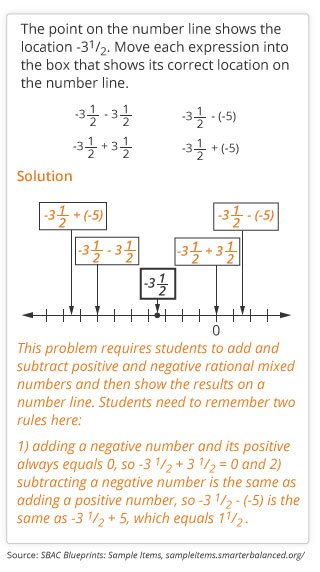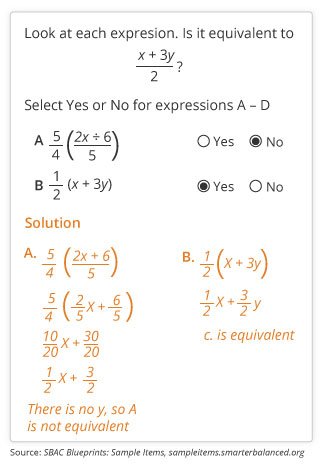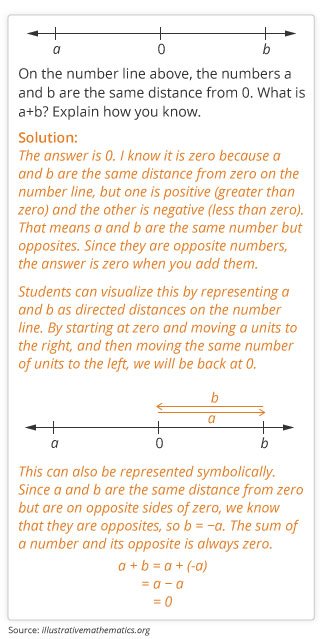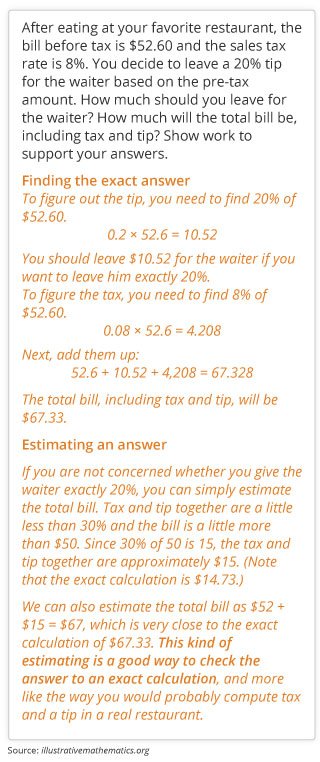Your feedback is important to us
Please provide any feedback you have. Thank you!
Thank you!
Your feedback has been submitted.
 California Assessment of Student Performance and Progress
California Assessment of Student Performance and Progress
Please provide any feedback you have. Thank you!
Your feedback has been submitted.

See what skills are tested, understand your child's scores, and get ideas for how you can help at home.
Seventh graders should be able to read and summarize material like Martin Luther King’s “I Have a Dream” speech, without inserting their own opinions.
To do this, students should use the author’s language as evidence for their summary. For example, a student might write, “We know the author doesn’t agree with factory pollution because he uses the words destructive and blame in the sentence. The destructive actions of factories are to blame.”
See what’s expected of middle school readers.

Seventh graders begin to analyze how the author uses specific words and phrases. They see how writers use personification (“The fire ran wild.”) to enhance descriptions. They also are discovering figures of speech such as metaphors (he’s a walking encyclopedia) that make the meaning of texts less literal. Students analyze how the language the author chooses can influence the text’s tone and meaning. Another lesson seventh graders learn is that many English words are based on Greek or Latin words. Recognizing those root words (astro in astronomer or mania in egomaniac) can help them determine the meaning of unknown words.
These lessons at BeaLearningHero.org will give your child some practical experience reading a variety of subjects, finding evidence, determining the main ideas, and using clues in the text to improve his skills. And check out the seventh grade book list; each book comes with a discussion guide so you can work with your tween on those reading necessary skills.
When you talk to your child’s teacher, ask what your child’s strengths and weaknesses are. Ask for specific examples of what your child is having trouble with. Is he making connections between multiple readings? Does she understand how to formulate a strong argument? Then ask the teacher for easy ways you can help at home.
By seventh grade, a student’s writing should be clear, focused, and interesting. Clear means using precise language so the reader can tell exactly what the writer is trying to say. Focused means sticking to a central idea and not getting sidetracked. And interesting means using examples that keep readers engaged.
Your child should find evidence from multiple sources — such as textbooks, articles, documentaries, graphs, and charts — and choose the best details to support her ideas.
By now, your seventh grader should have lots of experience quoting evidence she finds in books and articles.
Your child should also be choosing specific words and phrases, like investigate instead of look into, and use transition words such as however to improve the flow of his writing.
Whether your child is writing a report, an opinion piece, or a story, his writing should be organized into focused sections. For example, reports and persuasive pieces should start with a clear introduction and end with a summarizing conclusion. The paragraphs in between should provide details that connect to the main idea. In stories, students should use dialogue and description to move the plot along.
Finally, seventh graders are expected to use technology (such as the Internet and computers) to research, write, and publish their writing.
Writing gives kids the opportunity to play with words creatively. Encourage your child to try out words she’s learned and use silly descriptions when writing stories. If you notice errors in punctuation or spelling or see problems such as unclear handwriting, meet with her teacher to develop goals to improve those skills.
These tools at BeaLearningHero.org will help you understand what’s expected of your seventh grader when the test and teacher say write an informative/explanatory, argumentative, or narrative piece. Have your child watch the WriteAlong videos and practice as well.
Don’t forget that an involved parent still positively affects a child’s academic outcome — even at this age. Communicating with the teacher is one way to stay involved.
Seventh graders will spend a lot of class time discussing grade-specific topics — such as colonization — in pairs, small groups, and with the whole class.
They should use their listening skills to identify strong and weak arguments. They should use their speaking skills to add to others’ ideas or respectfully disagree.
In their presentations, seventh graders are expected to be specific. For example, in the case of colonization, settlers is more specific than newcomers.
Throughout the year, students work independently and in groups to present what they’ve learned. Presentations are expected to have text and visuals — and often students will use technology to create, display, or share their presentations.
In class, teachers will test and grade students on listening and speaking skills, but (for now) the state test only covers listening skills.
On the state test, students listen to a recording and answer questions about the main idea, the details, the presenter’s point of view, and new vocabulary words used.
How does your child handle class discussions? Does he raise his hand to participate or does he shy away from participating? Ask the teacher! Your seventh grader is expected to show off both listening and speaking skills; ask how you can help your child practice these skills at home.
Seventh graders should think critically about what information to use in their writing. They do this by asking themselves: What is the author’s motivation for writing? Is she selling me something? Does she want my support? Are there reasons not to trust this source?
By now, your seventh grader should have a lot of practice analyzing information from different sources, including books, documentaries, tables, and charts. Students should be able to find similarities and differences between how two or more authors present ideas on the same topic. They should also be able to evaluate the quality of the evidence cited and the tone of the author’s writing. These comparisons help them decide which source is the best one to use in their writing.
Here’s are some books recommended for seventh graders that come with discussion guides. You’ll know exactly how to get your child chatting and sharing the facts and her opinion with you!
Involved parent still positively affects a child’s academic outcome — even at this age. Ask the teacher what your child needs to work on to be better prepared for high school.
Seventh grade teachers do some heavy lifting. They begin to move students from arithmetic to algebra or, to put it another way, from learning about numbers to learning the mathematical reasoning that explains the relationships between numbers.
Students continue learning procedures, or how to solve problems, as well as the concepts behind those procedures, which is why they work.
Students need to understand the fundamentals of rational numbers. (Let’s set aside that the words middle schoolers and rational aren’t usually found in the same sentence.) Seventh graders need to know how to apply the four operations (+,-,x,÷) to all types of numbers within the rational number system, which includes any positive or negative whole number or decimal that can be expressed as a simple fraction. (Knowing what the rational number system includes helps you sound like an expert when badgering your children about their homework!)
Here’s where it gets a little complicated — no, make that exciting: a decimal that can be expressed as a fraction (including repeating decimals such as .333, which is 1⁄3) is rational, but a decimal that goes on forever (non-repeating) and can’t be expressed as a fraction, such as the square root of 2 or the mighty pi, Π, are known as irrational, but more on that in eighth grade. For now, focus on rational numbers.
In seventh grade, students continue to add, subtract, multiply, and divide, but now they are expected to be able to do this with all rational numbers — positive and negative numbers, fractions, and decimals. Students also have to be proficient at understanding and finding different representations of rational numbers, including converting decimals to fractions, fractions to decimals, and converting both fractions and decimals to percents. Students then need to show their understanding of rational numbers by solving word problems involving rational numbers.
Watch how seventh graders add and subtract with rational numbers.

In seventh grade, students learn new rules, procedures, and properties that they use to create and solve equations with negative numbers and variables. For example, adding a negative number to its positive (e.g., -4 + 4) always equals 0; the product of two negative numbers is always a positive number (-6 x -7 = 42); and the product of a negative number times a positive number is always a negative number (-8 x 6 = -48).
In sixth grade, students learned that a ratio is a way of comparing numbers, units, or quantities, such as running one mile in 6 minutes, 2 miles in 12 minutes, etc. These are known as proportional relationships. Seventh graders learn to use both fractions and decimals to display these relationships. They learn to test these relationships by modeling them on a chart, number line, table, or graph to show whether they really are proportional. If they are proportional, kids should be able to create an equation that represents the relationship.
Here’s an example of a proportional relationship turned into an equation. It’s based on running 1 mile in 6 minutes. If x equal miles and y equal minutes, this relationship would be written as 6x = y.
In addition to writing and solving equations with variables (ex: 2x + 4 = 12), seventh graders work with inequalities using greater than (>), greater than or equal to (≥), less than (<), and less than or equal to (≤). For example, say a salesperson is paid $50 per week plus $3 per sale, and this week the salesperson wants his pay to be at least $100. With x representing the number of sales, an inequality showing this might be $50 + $3x ≥ 100.
Sample problem 1: Adding and subtracting rational numbers

See how seventh graders explain the relationship between positive and negative numbers.

Sample problem 2: Using pictures to work with ratios/proportional relationships
Sample problem 3: Using tables, graphs, and equations to work with proportional relationships/ratios

Sample problem 4: Simplifying expressions to determine equivalence

Sample problem 5: Solving inequalities
Seventh graders encounter a lot of negative numbers, but remember to keep everyone’s attitude toward math positive. Research shows that your good attitude toward math will improve your child’s attitude — and his performance in math.
In middle school, it can be tougher to schedule time to talk to all of your child’s teachers, but it’s worth it! The best way to start a conversation with your seventh grader’s math teacher is to ask questions such as, What are the most important things my child should learn in your class this year? and What are typically the toughest concepts? What should I be on the lookout for in my child’s homework to make sure he’s getting it? Be ready to take notes on what the teacher says. When you talk about specifics, it’s easier to ask for resources, tips, and ideas on ways you can help your child.
Problem solving is the ability to make sense of a challenge, assess it, and come up with ways to work it out. It’s an incredibly useful skill in everyday life (especially for tweens dealing with peer pressure). It’s all about logic, which is the language of math. It requires being able to identify the important numbers and appropriate strategies to solve it. The problem-solving techniques students learn in seventh grade math will be useful throughout their lives in everything from computing interest rates on loans to calculating how much money they’ll earn over time.
Seventh graders need to apply their knowledge of proportional relationships to percents and solve multi-step word problems based on everyday situations, such as calculating simple interest on a small loan, finding the amount paid in sales tax, and figuring out the percent increase and decrease.
Modeling and data analysis means taking these sorts of real-world problems and using math to solve them — by creating a graph, drawing a picture, using a number line, creating a table, or building a model.
Solving multi-step word problems requires students to identify the parts of the problem, understand how the values are related, and then to perform multiple calculations to find the answer.
Sample problem 1: Solving multi-step word problems

Watch how these seventh graders solve a multi-step word problem.

The sample problem below is a multi-step ratio problem that can be approached in many ways. It can be solved by making a table, which helps show the pattern of taxi rates for different distances traveled. It is also possible to calculate a unit rate (dollars per mile), and use this to find the distance directly without making a table.
Sample problem 2: Solving real-life situations using a variety of strategies

Want to know the most important — and easiest — way to help your child? It’s having a positive attitude about math. Research shows that a parent’s attitude toward math is contagious; so just by having a good attitude, you are helping your child with math. So yes, you are a math whiz — and your child will be one, too.
Is your child good at problem solving? Ask the teacher! Your child’s math teacher has a whole new perspective to share with you about your child’s math skills. Ask to see a range of sample problems that seventh graders should be able to solve — from easy ones to brain-teasing stumpers. Can you solve them yourself? Ask the teacher to explain each one, and then take them home and try them with your child. Your interest + tackling problems together = a much more motivated math student.
Your child is probably already great at arguing (at least with you). Math is the class to let these skills shine — and to make them even stronger. Students are expected to be ready to defend their reasoning on any given problem. To do so, they must explain the processes they use to solve problems and support their answers using equations, diagrams, and other visuals.
Seventh graders are also required to use mathematical thinking and reasoning to critique their classmates’ work and explain why they think a solution is right or wrong. Students may be asked to compare two answers to the same word problem, identify the correct one, and support their decision using mathematical reasoning — including mental math — to estimate whether an answer even makes sense based on what they know about procedures and rules.
Sample problem 1: Developing a clear argument to explain and defend solutions

Sample problem 2: Critiquing the reasoning of others

Seventh graders should use their understanding of proportional relationships and their ability to simplify expressions and equations to do mental math to determine if an answer is reasonable. For example, they should know without having to calculate on paper that if a 2 pound bag of apples costs $5, it wouldn’t make sense for a 5 pound bag to cost $7, unless the store is giving a discount for buying in bulk.
Sample problem 3: Using mental math and estimation to determine whether an answer makes sense

Have fun with math! Cultivating a positive attitude toward math really is half the battle when it comes to your children excelling in math class. To get you started, here’s a math limerick for your problem-solving pleasure:
Reading I always did vanquish
Yet math, it made me anxious
But my child, I swear
She’ll never know fear
For her, numbers will never be fractious
Teachers are fountains of information, knowledge, and resources. Schedule a meeting to discuss your child’s math work. Ask the teacher to explain where your child is struggling using examples from his classwork, homework, or tests. Get some specific tips on how to help at home, including any websites or games that combine fun with learning.
GreatKids created this guide to help you understand your child's state test scores and to support your child's learning all year long. We worked with SBAC and leading teachers in every grade to break down what your child needs to know and exactly how you can help